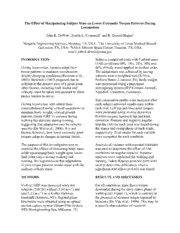
NASA Technical Reports Server (NTRS) 20070019365: The Effect of Manipulating Subject Mass on Lower Extremity Torque Patterns During Locomotion PDF
Preview NASA Technical Reports Server (NTRS) 20070019365: The Effect of Manipulating Subject Mass on Lower Extremity Torque Patterns During Locomotion
The Effect of Manipulating Subject Mass on Lower Extremity Torque Patterns During Locomotion John K. DeWitt1, Ronita L. Cromwell2 and R. Donald Hagan3 1Bergaila Engineering Services, Houston, TX, USA; 2The University of Texas Medical Branch, Galveston, TX, USA; 3NASA Johnson Space Center, Houston, TX, USA email: [email protected] INTRODUCTION Subjects completed trials with 5 added mass (AM) conditions (0%, 10%, 20%, 30% and During locomotion, humans adapt their 40% of body mass) applied in random order. motor patterns to maintain coordination The added mass was achieved by having despite changing conditions (Reisman et al., subjects wear a weighted vest (X-Vest, 2005). Bernstein (1967) proposed that in Perform Better, Cranston, RI). Body weight addition to the present state of a given joint, was maintained using a pneumatic other factors, including limb inertia and unweighting system (H/P/Cosmos Airwalk, velocity, must be taken into account to allow Nussdorf-Traunstein, Germany). proper motion to occur. Ten consecutive strides were analyzed after During locomotion with added mass each subject achieved steady-state within counterbalanced using vertical suspension to each trial. Left hip and knee joint torques maintain body weight, vertical ground were computed using inverse dynamics. reaction forces (GRF’s) increase during Positive torques represent hip and knee walking but decrease during running, extension. Positive and negative angular suggesting that adaptation may be velocity- impulse (AI) for each joint was found during specific (De Witt et al., 2006). It is not the stance and swing phase of each stride, known, however, how lower extremity joint respectively. Trial means for each variable torques adapt to changes in inertial forces. were computed for each condition. The purpose of this investigation was to Analysis of variance with repeated measures examine the effects of increasing body mass was used to determine the affect of AM while maintaining body weight upon lower- conditions on angular impulse. Separate limb joint torque during walking and analyses were conducted for walking and running. We hypothesized that adaptations running. Tukey-Kramer post-hoc tests were in joint torque patterns would occur with the used to determine differences when a addition of body mass. significant AM effect (p<0.05) was found. METHODS RESULTS AND DISCUSSION Vertical GRF was measured while ten For all conditions, knee flexor torque subjects (5M/5F) walked (1.34 m·s-1) and dominated during the early stance phase of ran (3.13 m·s-1) on a Kistler Gaitway walking (see Figure 1), which is contrary to treadmill (Amherst, NY). Sagittal plane the presence of extensor torque reported in kinematics were obtained using an optical literature (De Vita et al., 1996). This may be motion capture system (Smart Elite System, a specific characteristic of treadmill BTS Bioengineering Spa, Milanese, IT). locomotion that is not apparent during or running). Hip and knee AI were affected overground gait. by AM, but the effects were different between walking and running, and were During the stance phase, hip extensor AI inconsistent. It appears that the control increased with AM during walking, but was system adapts differently to walking with not affected during running. Hip flexor AI AM than running. increased with AM during running, but was unaffected during walking. Knee extensor REFERENCES AI was not affected by AM, but knee flexor AI increased with AM during running. Bernstein, NA. (1967). The Coordination and Regulation of Movements, 15-59. During the swing phase, AM did not affect Reisman, D. et al. (2005). J Neurophysiol, hip AI during walking, but both flexor and 94, 2403-2415. extensor AI decreased with increasing AM De Witt, J. et al. (2006). ASB Annual during running. Knee extensor AI decreased Meeting, www.asbweb.org/conferences/ with increasing AM during both walking 2006/pdfs/160.pdf. and running. Knee flexor AI during swing De Vita, P et al. (1996). J Biomech, 26, 583- was unaffected by AM in either gait mode. 588. SUMMARY/CONCLUSIONS AKNOWLEDGEMENTS Our findings suggest that when mass is We would like to thank the Exercise increased while maintaining body weight, Countermeasures Program at NASA – adaptations in joint torques occur that are Johnson Space Center for funding this study. specific to each locomotion style (walking W alking Running Hip Hip 200 200 N m) 100 N m) 100 e ( e ( qu 0 qu 0 or or T T oint -100 oint -100 J Stance J Stance -200 -200 0 20 40 60 80 100 0 20 40 60 80 100 % of stride % of stride Knee Knee 100 100 m) m) e (N 50 e (N 50 u u q q or or nt T 0 nt T 0 oi oi J J -50 -50 0 20 40 60 80 100 0 20 40 60 80 100 % of stride % of stride 0% AM 10% AM 20% AM 30% AM 40% AM Figure 1. Hip and knee joint torque trajectories during walking and running. Extensor torques are positive and flexor torques are negative.
